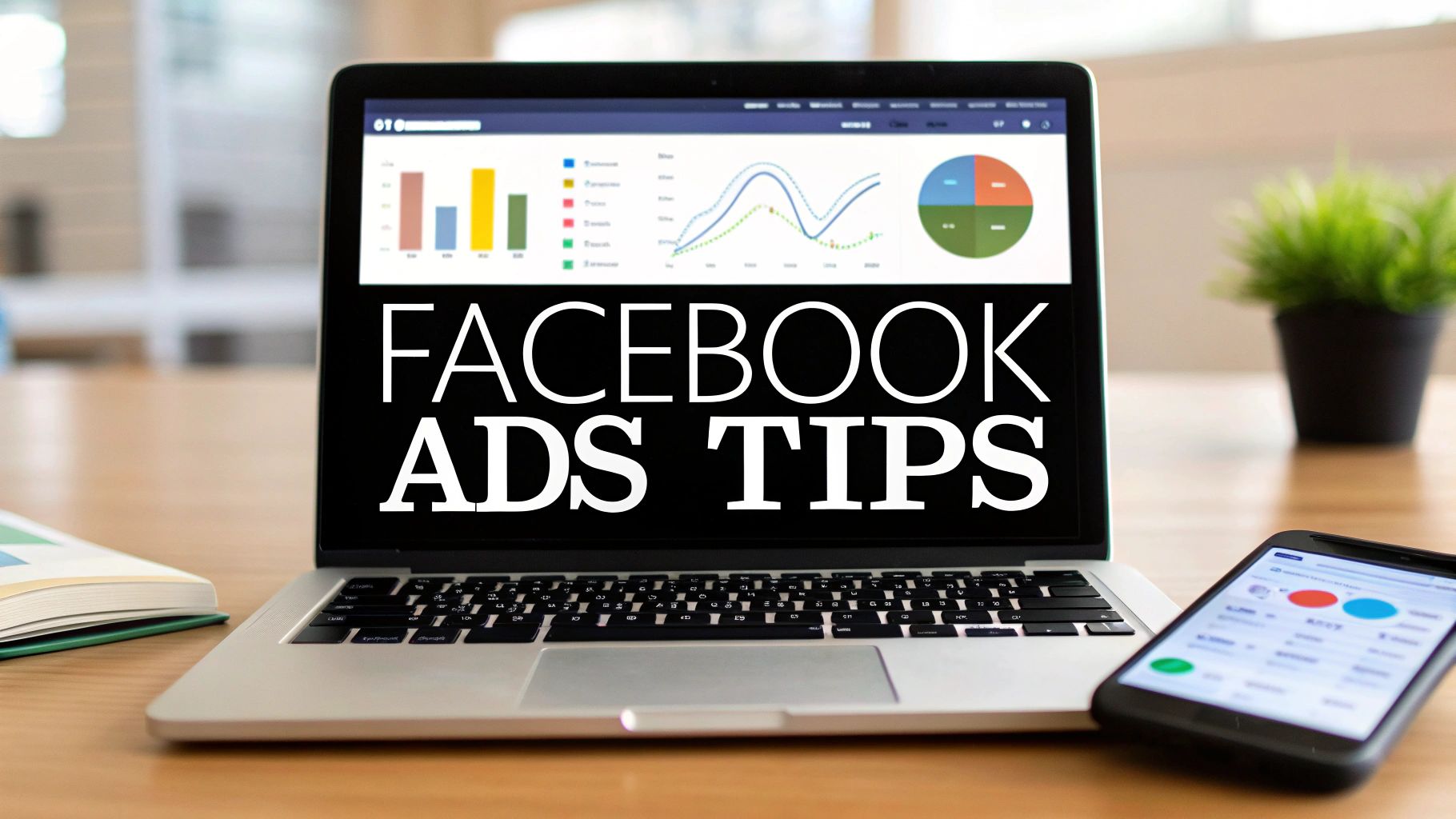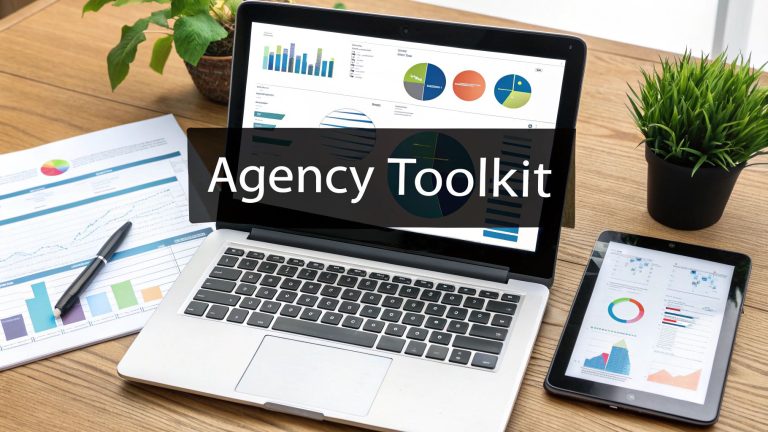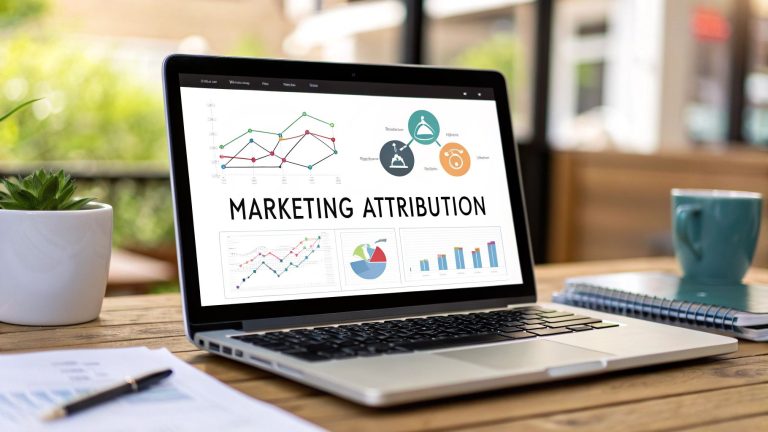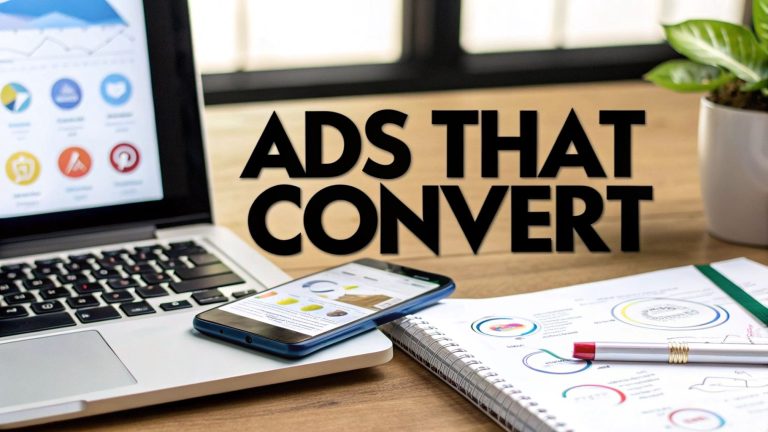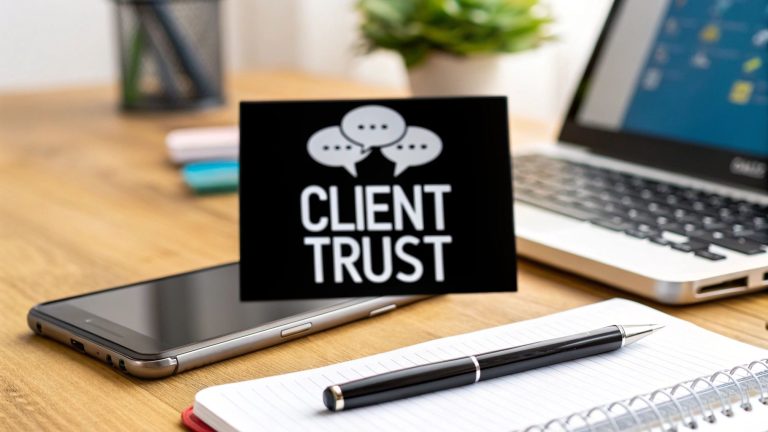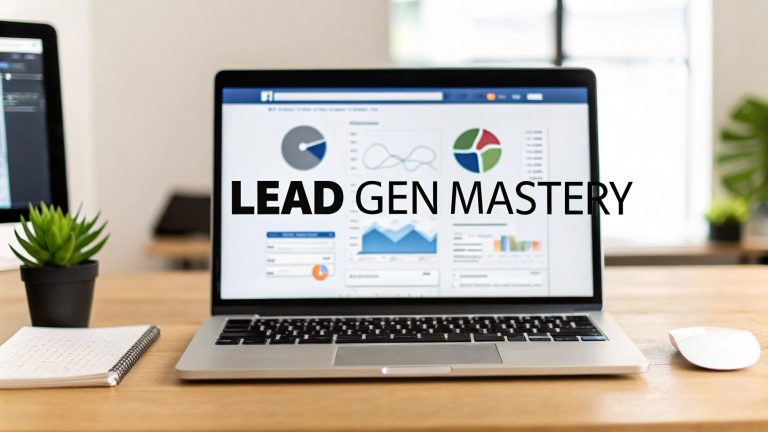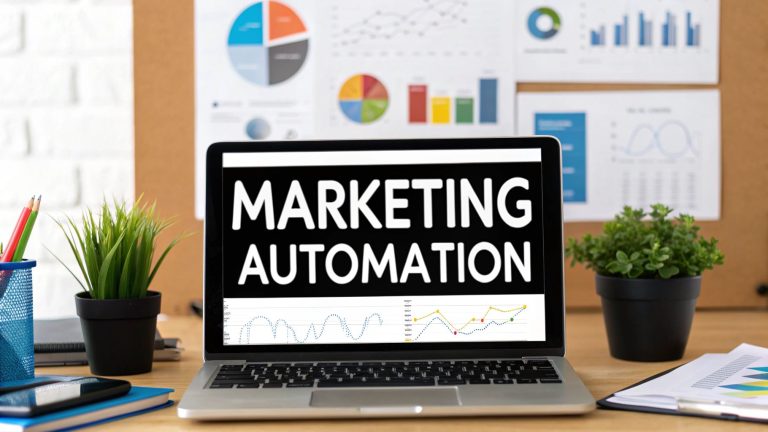10 Facebook Ads Best Practices for 2025: A Marketer’s Guide
Facebook's advertising landscape is more competitive than ever, but the formula for success remains rooted in strategic execution. Navigating the platform's complexities, from advanced targeting to privacy-centric tracking, requires a clear and effective framework. This guide moves beyond generic advice to provide 10 battle-tested Facebook Ads best practices that drive tangible business outcomes, giving you a competitive edge.
We will cover the entire campaign lifecycle. You will learn how to structure your campaigns for algorithmic success, craft thumb-stopping creative that converts, and scale your winning ads without sacrificing profitability. We'll also dive into critical technical aspects like leveraging the Facebook Pixel and Conversion API for accurate tracking and implementing systematic A/B tests to find what truly works.
This list is designed to be a definitive resource, offering actionable strategies to help you build, optimize, and scale campaigns that consistently deliver results. Whether you are a seasoned marketer fine-tuning your approach or a business owner building your first campaign, these insights will help you operate more efficiently and achieve your goals. Let's explore the strategies that separate the top 1% of advertisers from the rest.
1. Define Clear Campaign Objectives and Use Facebook's Campaign Structure
One of the most foundational Facebook ads best practices is to start with a clearly defined goal. Before you even think about creative or copy, you must align your campaign with a specific business outcome. Facebook’s platform is designed to help you do this through its hierarchical campaign structure, which guides its powerful optimization algorithm.
This structure operates on three distinct levels. At the top is the Campaign, where you select your primary objective (e.g., Awareness, Traffic, Conversions). This single choice tells Facebook’s algorithm precisely what you want to achieve. Below that is the Ad Set, where you define your audience, budget, schedule, and placements. Finally, at the bottom is the Ad, which contains your creative elements like images, videos, and copy.
This infographic illustrates the three-level hierarchy of a Facebook Ads campaign.
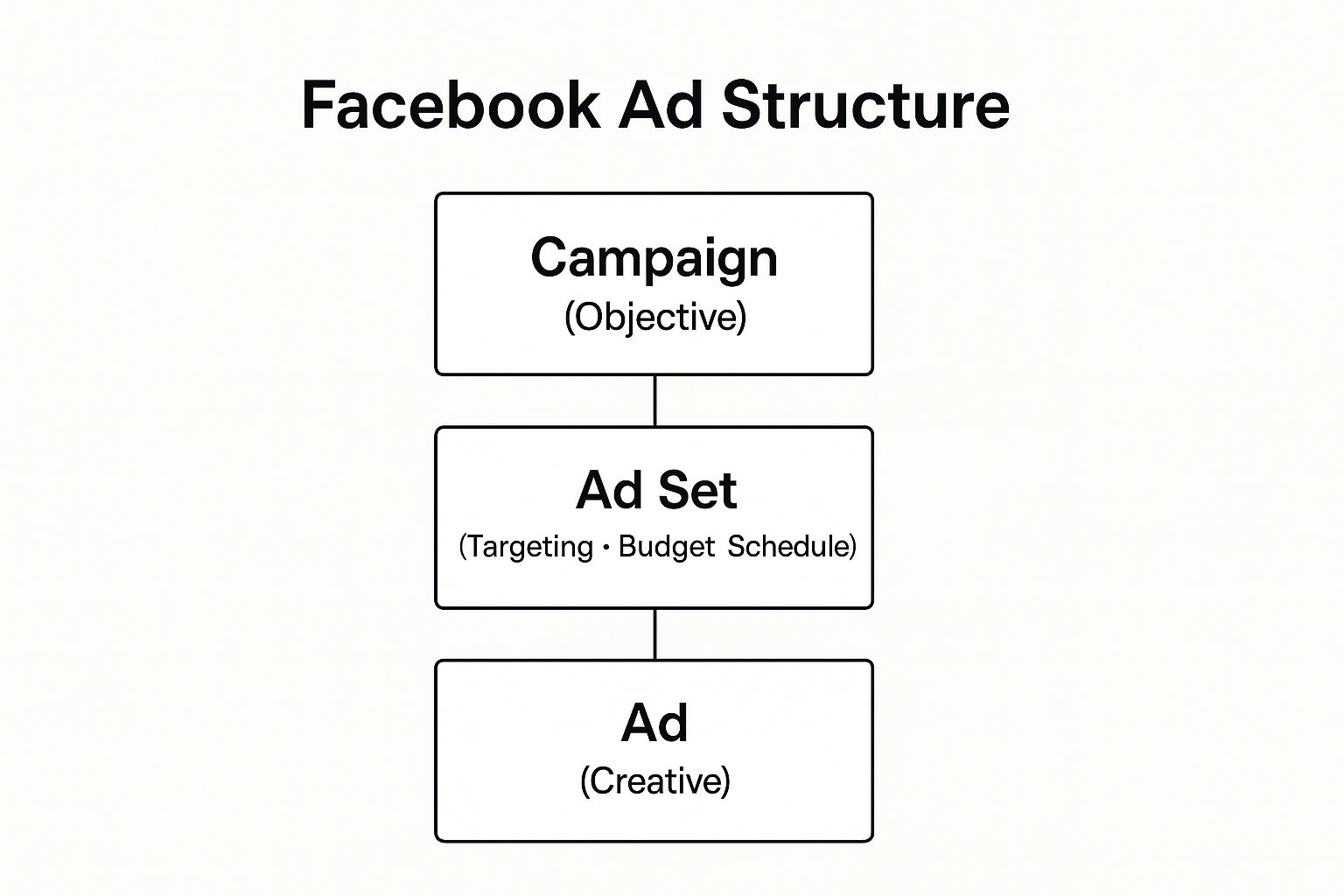
This top-down structure ensures that your high-level objective dictates all subsequent targeting and creative decisions, creating a focused and efficient campaign.
Why This Structure Is Crucial
Choosing the right objective is not a trivial step; it directly impacts your results. An e-commerce brand that switched from a "Traffic" objective to a "Conversions" objective (optimized for Purchase) saw a 3x improvement in ROAS because the algorithm targeted users more likely to buy, not just click. Similarly, a B2B company using the "Lead Generation" objective reduced its cost per lead by 47% compared to campaigns sending users to a landing page.
Actionable Tips for Implementation:
- Align Objectives with Funnel Stage: Use Awareness or Traffic objectives for cold audiences unfamiliar with your brand. Use Consideration (e.g., Lead Generation) or Conversion objectives for warm or hot audiences who are ready to take action.
- Install Your Facebook Pixel: You cannot effectively use Conversion objectives without a properly installed and tested Facebook Pixel. This is non-negotiable for tracking actions like purchases or sign-ups.
- Be Patient with the Algorithm: Once you set an objective, allow the campaign to run for at least seven days before making significant changes. This gives the algorithm enough time to exit the "learning phase" and stabilize performance.
- Maintain a Clean Structure: Start with one objective per campaign. This prevents your data from becoming muddled and allows you to clearly identify which goals are driving the best results.
2. Implement Advanced Audience Targeting and Segmentation
Moving beyond generic demographics is a cornerstone of effective Facebook ads best practices. Reaching the right person with the right message at the right time is paramount, and Facebook’s platform offers sophisticated tools to achieve this. Advanced targeting allows you to segment users based on their online behaviors, interests, and relationship with your brand.
This involves leveraging features like Custom Audiences, which are built from your existing customer data (e.g., email lists, website visitors), and Lookalike Audiences, which find new users who share traits with your best customers. Strategic audience segmentation ensures your ad spend is directed toward users who are most likely to convert, dramatically improving campaign efficiency.
Why This Targeting Is Crucial
Precise targeting prevents wasted ad spend and significantly boosts ROI. A fashion retailer that created a 1% Lookalike Audience from its top 5% of purchasers achieved a 2.8x higher ROAS compared to interest-based targeting. Similarly, a SaaS company retargeting website visitors who viewed its pricing page saw a 5x higher conversion rate than with its cold traffic campaigns. These results underscore the power of showing ads to qualified, high-intent audiences.
Actionable Tips for Implementation:
- Start with Warm Audiences: Prioritize campaigns targeting Custom Audiences (website visitors, past purchasers) as they provide the highest return. Use these warm audiences as a foundation before expanding to colder prospecting.
- Layer Lookalike Audiences: Create Lookalike Audiences from high-value sources like your customer list or top spenders. Test 1-2% similarity for the highest quality prospects and expand to 5-10% for greater reach.
- Exclude Existing Converters: To maximize budget efficiency, always exclude recent purchasers or leads from your prospecting campaigns. This simple step prevents you from paying to advertise to people who have already converted.
- Segment by Funnel Stage: Create separate ad sets for different audience temperatures. Deliver brand awareness messaging to cold Lookalike audiences and direct-response offers to warm retargeting audiences.
- Test Advantage+ Audience: Use Facebook's Advantage+ audience feature to test a broader targeting approach against your more detailed, segmented audiences. This can help you find new pockets of customers you hadn't considered.
3. Master Creative Best Practices with Thumb-Stopping Content
In a crowded, fast-scrolling news feed, your ad creative is often the single most important factor for success. One of the most critical Facebook ads best practices is to develop “thumb-stopping” content that grabs a user’s attention within the first three seconds. This means combining compelling visuals, a strong hook, and clear messaging that resonates instantly.
Gone are the days when generic stock imagery could drive results. Today’s top-performing campaigns leverage authentic content like user-generated photos, dynamic video, and mobile-optimized creative designed for vertical viewing. The creative is the highest-leverage element you can test, often producing more significant performance gains than audience or placement tweaks.
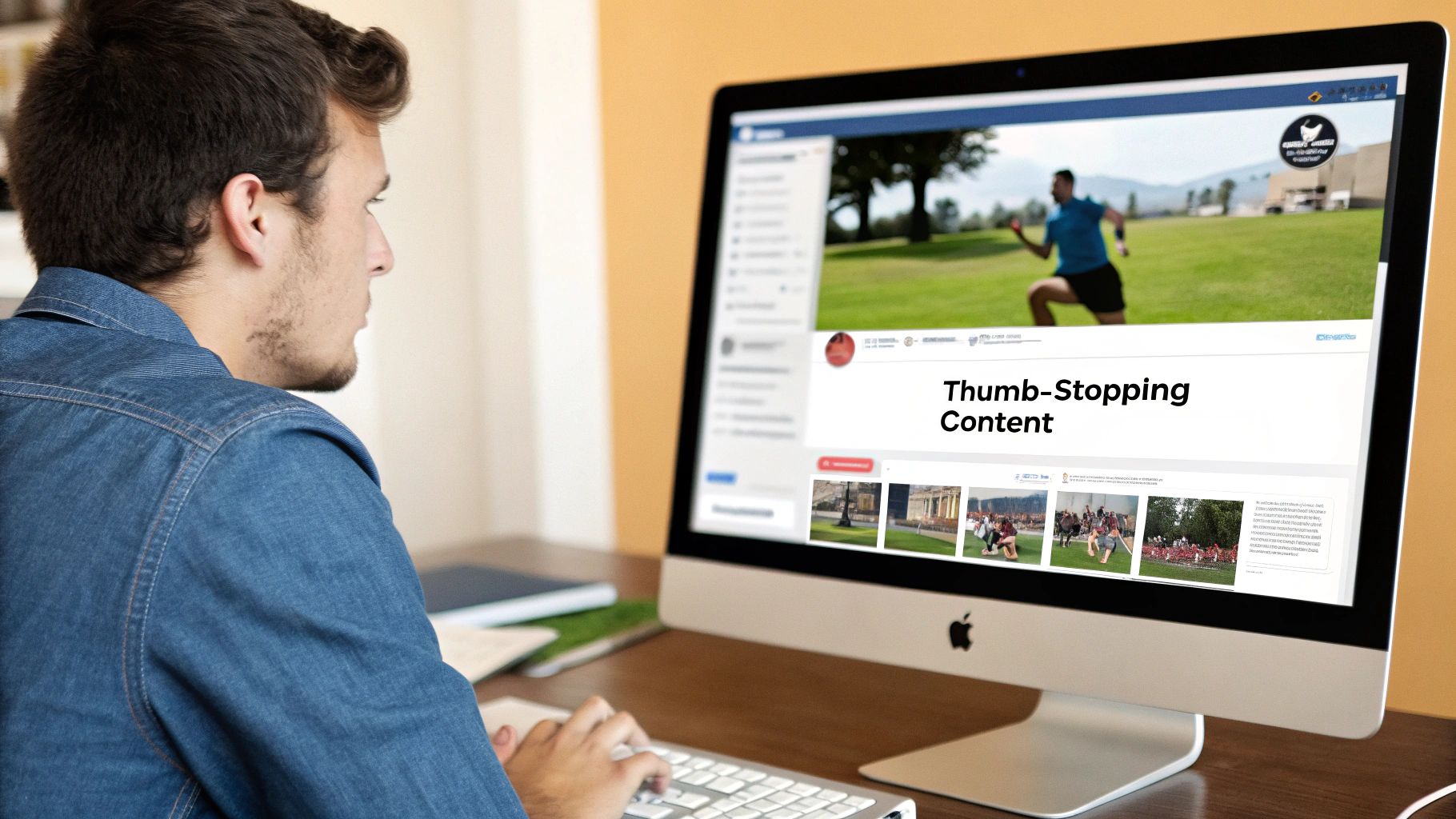
Why Creative Is Crucial
Your creative directly impacts your ad’s relevance score, click-through rate (CTR), and ultimately, your cost per result. For example, Dollar Shave Club’s humorous, low-budget video ad famously generated 12,000 customers in just 48 hours because it was authentic and disruptive. Similarly, beauty brand Glossier saw a 35% lower CPA by using user-generated content compared to polished, professional photography, as it built social proof and relatability. To craft truly effective visuals and text that convert, explore these powerful ad copy examples for inspiration that can drive conversions.
Actionable Tips for Implementation:
- Hook Viewers Immediately: Start your video with a bold statement, an intriguing question, or a pattern-interrupting visual to capture attention in the first 1-3 seconds.
- Design for Mobile and Sound-Off: Always use vertical or square formats. Since 85% of users watch videos without sound, burn-in captions are non-negotiable for conveying your message.
- Prioritize Authenticity: Use real people, user-generated content, or behind-the-scenes footage. This builds trust far more effectively than glossy, impersonal stock photos.
- Refresh Creative Regularly: Combat ad fatigue by introducing new creative variations every 7-14 days. Test different hooks, visuals, and copy angles to maintain performance.
4. Optimize Budget Allocation and Bidding Strategy
One of the most critical Facebook ads best practices for maximizing return is mastering budget allocation and bidding. How you spend your money is just as important as your audience and creative. Effective management involves choosing the right budgeting method, like Campaign Budget Optimization (CBO), and pairing it with a smart bidding strategy that aligns with your goals.
At the campaign level, you can choose between Campaign Budget Optimization (CBO) or Ad Set Budget Optimization (ABO). CBO allows Facebook's algorithm to automatically distribute your budget to the best-performing ad sets in real time. In contrast, ABO (manual budgeting) gives you direct control over how much is spent on each specific ad set. The choice depends entirely on your campaign goals and testing structure.
Why This Strategy Is Crucial
Effective budget and bid management directly impacts your cost per acquisition and scalability. An e-commerce brand that switched to CBO saw a 23% reduction in cost per purchase while maintaining conversion volume because the algorithm efficiently shifted spend to the winning audience. Similarly, a B2B company using a "Cost Cap" bid strategy stabilized its cost per lead within a 10% variance of its target CPA, enabling predictable and scalable lead generation.
Actionable Tips for Implementation:
- Use CBO for Scale: Leverage CBO for campaigns with 2-5 proven ad sets to let the algorithm find the most efficient conversions. Use ABO for granular testing of new audiences or creatives where you need to force equal spending.
- Set Minimums with CBO: If using CBO with multiple ad sets, set minimum ad set spend limits (e.g., 20% of the daily budget) to ensure smaller audiences get a fair chance to deliver results.
- Scale Budgets Gradually: To avoid resetting the learning phase and causing performance volatility, increase your budget by a maximum of 20% every 48-72 hours.
- Start with 'Lowest Cost' Bidding: Begin new campaigns with the 'Lowest Cost' (now 'Highest Volume') bid strategy to establish a baseline CPA. Once you have stable data, switch to a 'Cost Cap' to maintain profitability while scaling.
- Allocate Budget for Testing: A common best practice is to allocate 70% of your budget to proven, successful campaigns (your "winners") and reserve 30% for systematically testing new audiences and creative angles.
5. Leverage the Facebook Pixel and Conversion API for Accurate Tracking
One of the most critical Facebook ads best practices is to establish robust and accurate tracking. This is achieved through the combined power of the Facebook Pixel and the Conversions API (CAPI). The Pixel is a code snippet on your website that tracks visitor actions, while CAPI sends data directly from your server to Facebook, bypassing browser-level tracking limitations.
Using them together creates a redundant and more reliable data stream. This dual-tracking approach is no longer optional; it is essential for accurate attribution, effective optimization, and powerful retargeting in a privacy-focused digital landscape. By feeding the algorithm more complete data, you enable it to find the most valuable users for your business.
Why This Structure Is Crucial
Inaccurate data leads to wasted ad spend. With browser restrictions and ad blockers limiting the Pixel’s effectiveness, relying on it alone means you're missing a significant portion of your conversion data. A Shopify store that implemented CAPI alongside its Pixel saw a 43% increase in attributed conversions, allowing its optimization algorithm to perform with much greater efficiency. Similarly, a SaaS company tracking multi-step funnel events reduced its cost per trial by 58% after using CAPI to reliably fire its "Trial Start" event.
Actionable Tips for Implementation:
- Install Both Pixel and CAPI: Set up both tracking methods to maximize data capture. Aim for an Event Match Quality score of 8 or higher in your Events Manager to ensure data is properly deduplicated.
- Prioritize Your Top 8 Events: Due to Apple's App Tracking Transparency (ATT) framework, you can only optimize for a maximum of eight conversion events. Choose the ones most critical to your business, such as Purchase, Lead, or Complete Registration.
- Enable Advanced Matching: Turn on Advanced Matching to securely pass hashed customer data like email addresses and phone numbers. This dramatically improves Facebook's ability to attribute conversions to the correct users across devices. You can learn more about this in our guide to Facebook Ads conversion tracking.
- Optimize for High-Value Actions: Don't just optimize for "Page Views." Configure your campaigns to optimize for bottom-of-funnel events like "Purchase" or "Schedule Call" to signal to the algorithm exactly what you want more of.
6. Conduct Systematic A/B Testing (Split Testing)
Guesswork has no place in a high-performing ad account. One of the most critical Facebook ads best practices is to make data-driven decisions through systematic A/B testing. Facebook’s built-in split testing feature allows you to isolate and test one variable at a time, such as creative, audience, or placement, to determine with statistical significance what truly drives results.
This methodical approach prevents you from making changes based on gut feelings and instead builds a reliable foundation for scaling your campaigns. By creating controlled experiments, you can scientifically prove which ad elements resonate most with your audience, leading to compounding performance gains over time.
Why This Structure Is Crucial
Systematic testing directly impacts your bottom line by revealing hidden pockets of efficiency. For example, a software company testing a 1% Lookalike Audience against a 5% Lookalike discovered the smaller, more precise 1% audience delivered double the ROAS, despite having a higher CPM. Similarly, a B2B service testing a pain-point headline ("Struggling with low lead quality?") against a benefit-focused one ("Get high-quality leads now") saw a 41% conversion rate increase with the pain-point approach.
Actionable Tips for Implementation:
- Test One Variable at a Time: To get clean data, only change one element between your ad sets (e.g., test two different creatives against the exact same audience and placement).
- Use Facebook's Split Test Feature: Use the official feature to ensure Facebook splits the budget evenly and prevents audience overlap between your test variations.
- Prioritize High-Impact Tests: Start by testing variables with the highest potential for impact. A common testing hierarchy is: Audience → Creative → Ad Copy → Placement.
- Run Tests Long Enough: Let tests run for a minimum of 7-14 days to gather enough data and account for weekly performance fluctuations. Don't end a test early just because one variation seems to be winning after two days.
7. Create Effective Retargeting Campaigns Using the Marketing Funnel
One of the most powerful Facebook ads best practices is retargeting users who have already interacted with your business but haven't converted. These warm audiences are significantly more likely to take action because they already have brand familiarity. A full-funnel approach moves beyond simple website visitor retargeting and customizes messaging based on a user's specific level of engagement.
This strategy involves showing different ads to different audience segments. For example, you would show awareness-focused content to cold audiences, consideration-focused ads to engaged users (like video viewers or page followers), and direct conversion offers to hot prospects (like cart abandoners or people who visited a pricing page).
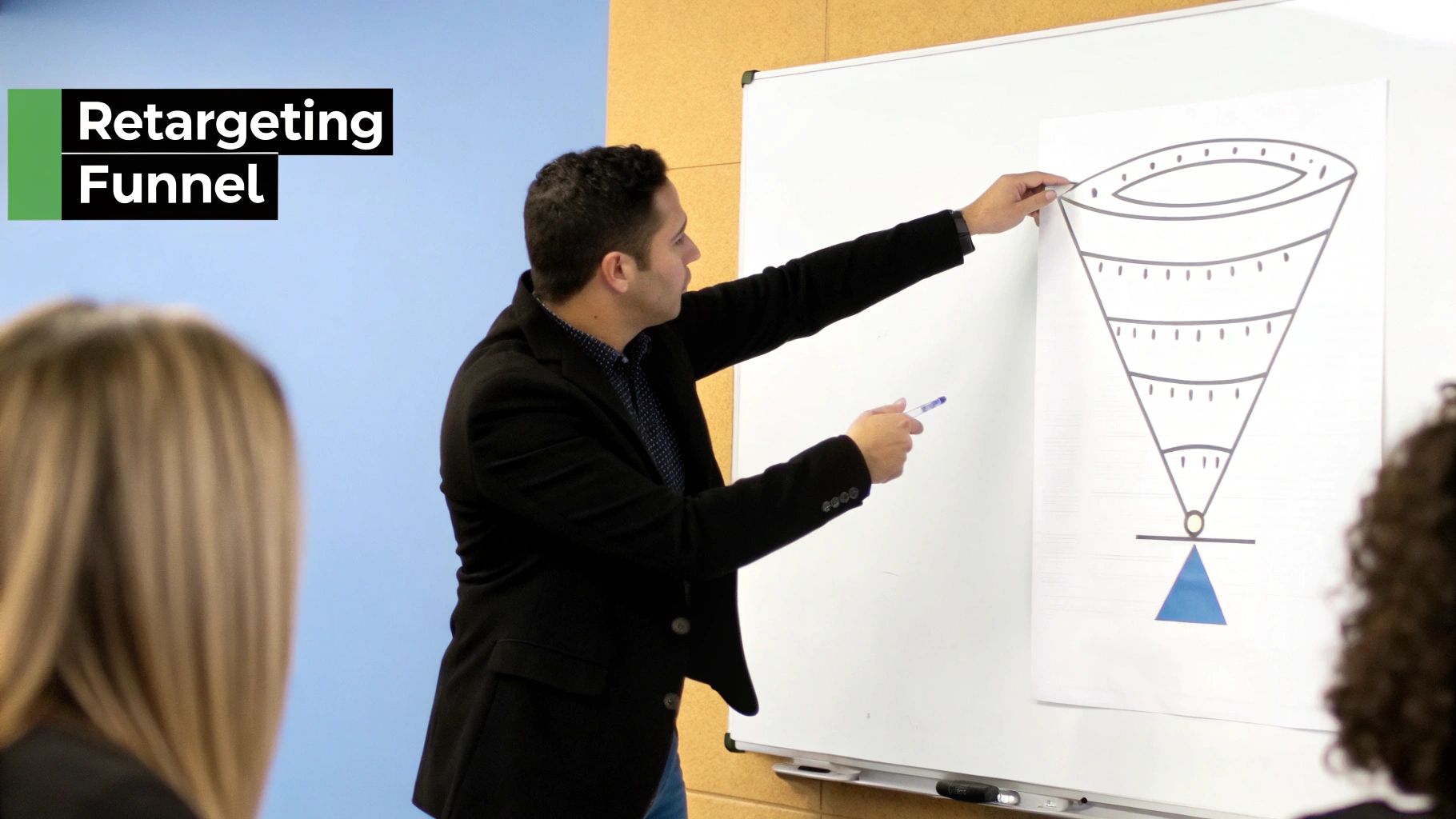
This segmented method ensures your message is always relevant to the user's journey, dramatically increasing its effectiveness.
Why This Structure Is Crucial
Funnel-based retargeting works because it meets customers where they are. An e-commerce store using dynamic product ads for cart abandoners recovered 15% of abandoned carts by showing users the exact items they left behind. Similarly, a SaaS company that created a sequential retargeting campaign (showing a case study, then a demo, then a trial offer) increased its trial sign-ups by a staggering 94%. This is because the ads nurtured the user's interest instead of just asking for a sale immediately.
Actionable Tips for Implementation:
- Segment Your Audiences by Intent: Create separate custom audiences for "hot" leads (cart abandoners, viewed pricing page), "warm" leads (viewed product pages, watched 50% of a video), and "lukewarm" leads (homepage visitors, social media engagers).
- Use Appropriate Time Windows: Target hot audiences with a short window (e.g., 7-14 days) to capitalize on immediate interest. Use longer windows (30-90 days) for warmer or lukewarm audiences to stay top-of-mind.
- Exclude Recent Converters: Always exclude customers who have recently purchased or signed up from your retargeting campaigns to avoid wasting ad spend and annoying your new customers.
- Leverage Dynamic Product Ads: For e-commerce, Dynamic Ads are essential. They automatically show products from your catalog that users have previously viewed or added to their cart, creating a highly personalized experience.
8. Optimize Landing Pages for Conversion and Consistency
Your Facebook ad is only the beginning of the customer journey; a compelling ad that leads to a poor landing page experience will waste your ad spend. One of the most critical Facebook ads best practices is ensuring the post-click experience is seamless, consistent, and optimized for a single goal. The landing page must fulfill the promise made in the ad to convert clicks into customers.
This means maintaining a strong "message match" between your ad creative and your landing page, ensuring fast load times, and designing a clear, friction-free path to conversion. Even a one-second delay in page load can reduce conversions by 7%, while a disconnect between your ad's headline and your page's headline can cut conversion rates in half.
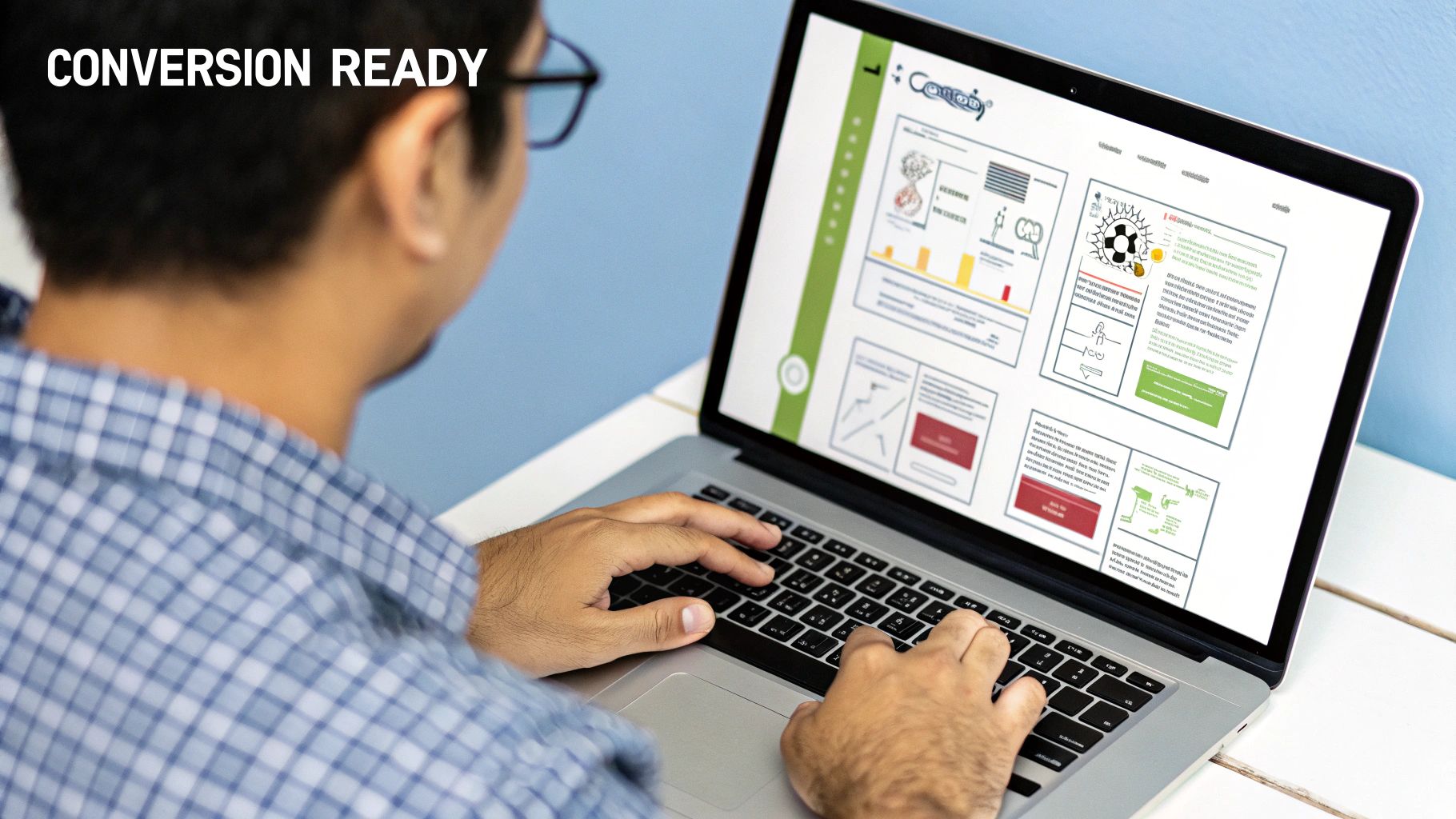
Why This Is Crucial
The post-click experience directly determines your campaign's profitability. A local service business that optimized its mobile page speed from seven seconds to two seconds saw its bounce rate drop from 65% to just 28%. Similarly, a SaaS company increased lead submissions by 120% simply by reducing its form fields from eight to three. These optimizations turn ad clicks into tangible business results.
Actionable Tips for Implementation:
- Maintain Perfect Message Match: Ensure your landing page headline exactly mirrors your ad's headline. This consistency builds immediate trust and reassures users they are in the right place.
- Optimize for Mobile-First: With over 90% of Facebook traffic coming from mobile devices, your landing page must be designed and tested for a flawless mobile experience.
- Prioritize Page Speed: Aim for a load time under three seconds. Compress images, minimize scripts, and use fast hosting to prevent users from bouncing before your page even loads. To ensure your ad traffic converts effectively, explore these essential landing page design best practices.
- Simplify the Conversion Path: Place your primary call-to-action (CTA) above the fold and minimize form fields to ask only for essential information. Each extra field adds friction and reduces the likelihood of completion. If you want to dive deeper, you can learn more about improving website conversion rates.
9. Monitor Metrics That Matter and Understand Attribution
One of the most critical Facebook ads best practices is focusing on the right performance indicators. The Facebook Ads Manager provides dozens of metrics, but success lies in tracking KPIs that align directly with your business goals, not vanity metrics like reach or impressions that rarely correlate with profit.
Understanding attribution is equally important. Facebook reports conversions based on its own model, which often differs from what your own analytics platform, like Google Analytics or Shopify, will show. This discrepancy arises from different tracking methods and attribution windows. Recognizing this gap is key to making informed budget decisions and setting realistic performance expectations.
Why This Focus Is Crucial
Focusing on the wrong metrics can lead you to scale losing campaigns or kill winning ones. An e-commerce brand, for example, might see a fantastic 3.2x ROAS reported inside Ads Manager but only a 2.1x ROAS in their Shopify analytics. By understanding the attribution difference, they can adjust their bidding strategy based on real-world profit rather than platform-inflated numbers. Similarly, a B2B company that goes beyond cost per lead to monitor placement breakdowns might discover that Instagram Stories generate leads for 45% less than the Facebook Feed, allowing for a strategic budget reallocation.
Actionable Tips for Implementation:
- Focus on Business Outcomes: Prioritize metrics that directly impact your bottom line. For e-commerce, this is Return on Ad Spend (ROAS). For lead generation, it's Cost Per Lead (CPL) or Cost Per Acquisition (CPA).
- Use 7-Day Click Attribution: For most businesses, the 7-day click attribution window is the standard for decision-making as it balances recency with a complete view of user behavior.
- Compare Platform Data: Regularly compare Facebook-reported results with your primary source of truth (e.g., Shopify, Google Analytics 4). Use UTM parameters to track Facebook traffic accurately in external tools.
- Monitor Secondary Metrics: Keep an eye on secondary indicators like Click-Through Rate (CTR) and Frequency. A CTR above 1-2% is healthy, while a Frequency creeping above 3-4 can signal audience saturation and ad fatigue. You can learn more about attribution modeling here to deepen your understanding.
10. Scale Campaigns Strategically While Maintaining Efficiency
One of the most challenging Facebook ads best practices is scaling a successful campaign without destroying its profitability. Simply increasing the budget on a winning ad set can often shock the algorithm, reset the learning phase, and lead to a dramatic drop in performance. Strategic scaling involves methods that preserve efficiency as you increase spend.
The two primary approaches are vertical scaling, which involves incrementally increasing the budget of a proven ad set, and horizontal scaling, which means duplicating the winning ad set to target new audiences. Vertical scaling is best for steady growth, while horizontal scaling allows you to expand your reach into new markets or demographic segments. Combining both methods is key to sustained, profitable growth.
Why Strategic Scaling Is Crucial
Scaling too quickly is a common way advertisers burn through their budget. For example, a supplement brand maintained a 2.5x ROAS while scaling from $500 to $50,000 per day by only increasing budgets by 20% every three days. In contrast, an advertiser who doubles their budget overnight often sees their cost per acquisition (CPA) skyrocket because the algorithm is forced to find less-qualified users to spend the new budget.
Actionable Tips for Implementation:
- Wait for the Learning Phase to End: Before attempting to scale, ensure your ad set has generated at least 50 conversions and exited the "learning phase." Scaling during this period causes performance volatility.
- Use the 20% Rule for Vertical Scaling: Increase the budget of a winning ad set by a maximum of 20% every 48 to 72 hours. This gradual increase prevents the algorithm from re-entering the learning phase.
- Scale Horizontally to New Audiences: Duplicate your successful ad set and test it on new, similar audiences. This could include broader lookalikes (e.g., from 1% to 5%) or new interest groups.
- Only Scale Your Winners: Do not increase the budget on underperforming ad sets hoping they will improve. Focus your resources exclusively on proven performers.
- Monitor Frequency: As you scale, keep a close watch on ad frequency. A frequency above 4 or 5 often indicates audience saturation, signaling that it's time to introduce new creative or target a different audience.
Top 10 Facebook Ads Best Practices Comparison
| Strategy | Implementation Complexity 🔄 | Resource Requirements ⚡ | Expected Outcomes 📊 | Ideal Use Cases 💡 | Key Advantages ⭐ |
|---|---|---|---|---|---|
| Define Clear Campaign Objectives and Use Facebook's Campaign Structure | Medium – requires understanding hierarchical setup | Moderate – pixel setup needed for conversions | Higher ROI via objective-specific optimization | Aligning ads to business goals; testing and scaling | Algorithm optimization; clear organization; better ROI |
| Implement Advanced Audience Targeting and Segmentation | High – detailed audience research | Moderate to High – needs data and segmentation tools | Precision targeting; cost reduction | Reaching right users; retargeting; scaling audiences | Reduces wasted spend; improves conversion rates |
| Master Creative Best Practices with Thumb-Stopping Content | Medium to High – ongoing creative production | High – content creation and refresh cycles | Significantly improved engagement and conversions | Boosting ad engagement; brand trust building | Strong creative impact; multiple format options |
| Optimize Budget Allocation and Bidding Strategy | Medium – requires strategy and monitoring | Moderate – budget for testing and learning | Cost efficiency; scalable spend | Efficient budget use; campaign scaling | Automated budgets; improved cost control; scalable |
| Leverage the Facebook Pixel and Conversion API for Accurate Tracking | High – technical pixel and server setup | Moderate to High – developer support needed | Accurate tracking; better attribution | Conversion optimization; retargeting; ROAS tracking | Improved data accuracy; recovers conversions lost to iOS |
| Conduct Systematic A/B Testing (Split Testing) | Medium – structured testing process | Moderate – requires sufficient budget and time | Data-driven decisions; performance gains | Creative, audience, placement, bids testing | Statistically valid; removes guesswork; knowledge building |
| Create Effective Retargeting Campaigns Using the Marketing Funnel | Medium – setup of funnel stages | Moderate – pixel/CAPI and audience size needed | Higher conversion rates at lower cost | Nurturing warm audiences; cart abandoners | 2-3x conversion rates; cost-effective; multi-stage messaging |
| Optimize Landing Pages for Conversion and Consistency | Medium to High – may need web dev resources | Moderate – tools or dev time | Increased conversion rates | Improving post-click experience; reducing bounce | Doubles conversions; lowers CPC; consistent brand experience |
| Monitor Metrics That Matter and Understand Attribution | Medium – analytics setup and interpretation | Low to Moderate – reporting tools | Better optimization decisions | Campaign performance evaluation | Focused KPIs; attribution clarity; actionable insights |
| Scale Campaigns Strategically While Maintaining Efficiency | High – needs strategic planning and monitoring | Moderate to High – budget for scaling | Increased ROI with controlled cost increases | Growing ad spend profitably; expanding reach | Maintains efficiency; diversified growth; reduces risk |
Bringing It All Together: From Best Practices to Business Growth
Navigating the landscape of Facebook advertising can feel like a complex puzzle, but by applying the foundational principles we've covered, you can piece together a powerful and profitable strategy. This guide has walked you through ten critical pillars, from establishing clear campaign objectives and mastering audience segmentation to optimizing ad creative and scaling your winners. The journey from a novice advertiser to a seasoned expert is built on these very concepts.
Remember, success isn't about finding a single "magic bullet." Instead, it's about creating a holistic system where each component supports the others. Your thumb-stopping creative will only perform if it reaches the right audience. Your perfectly segmented audience won't convert without a consistent and optimized landing page experience. And none of it matters if you can't accurately track results with the Facebook Pixel and Conversion API to make data-driven decisions.
From Theory to Actionable Growth
The true value of these Facebook ads best practices is unlocked when they are put into consistent practice. Treat them not as a one-time checklist but as an ongoing operational framework for continuous improvement.
- Embrace the Cycle: The core loop of a successful advertiser is simple: Test, Measure, and Iterate. Systematically A/B test your creative, targeting, and landing pages. Use the data you gather to refine your approach and inform your next move.
- Focus on the Funnel: Always consider where your audience is in their journey. A cold prospect needs a different message than a warm lead who has already visited your website. Tailoring your retargeting efforts to each stage of the marketing funnel is non-negotiable for maximizing ROI.
- Prioritize Efficiency: As you begin to see results, the challenge shifts from getting conversions to getting them efficiently. This is where strategic budget allocation, smart bidding strategies, and a deep understanding of your key performance metrics become paramount for sustainable scaling.
Mastering these elements transforms Facebook Ads from an unpredictable expense into a reliable engine for business growth. It allows you to move beyond simply boosting posts and start building a predictable pipeline of leads and sales. However, strategy is only half the battle; operational efficiency is the other. Many businesses find that while their lead generation campaigns are successful, the manual process of handling those leads creates a significant bottleneck, especially with Facebook Lead Ads. Slow lead follow-up is a primary cause of lost revenue.
Ready to close the gap between lead generation and sales conversion? Many of the Facebook ads best practices focus on generating high-quality leads, but quick follow-up is what turns them into customers. LeadSavvy Pro automates the tedious process of downloading CSVs by instantly syncing your Facebook Lead Ad data directly to your CRM or Google Sheets. Start your free trial today and ensure no lead ever goes cold again by visiting LeadSavvy Pro.

